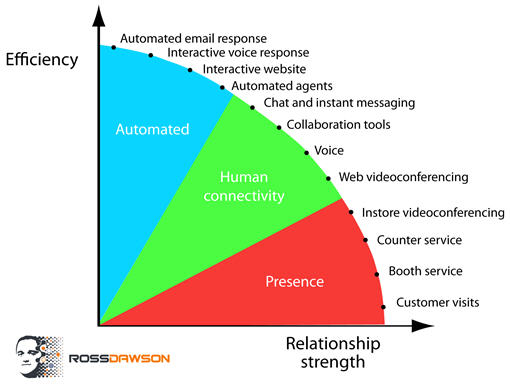The Future of Customer Service: Using technology to increase both efficiency and relationship strength
Last week I gave the closing keynote at KANA Connect 2012 in Las Vegas, on The Future of Customer Service.
I packed in a wide-ranging view on where customer service is going, including the impact of connectivity, the rise of new channels, where value will reside in relationships, and what supports the integration and integrity that will be at the heart of successful customer service.
One of the key areas I covered was the shift in customer service channels, using a diagram I originally created for a keynote and supporting article on Creating the Future of Customer Relationships.

Back in 1999 Evans and Wurster in their book Blown to Bits said that the trade-off between richness and reach had disappeared. That wasn’t true. Today the trade-off between what I prefer to call Relationship Strength and Efficiency is eroding, but still exists. The challenge today is to continue to push out against that trade-off, while recognizing that it will never entirely disappear.
A large part of the path forward is in using technologies. There are three categories of channels for customer service:
Presence. There is no substitute for people being physically present in the same place, which allows them to sit down together, converse, relate as humans, and discover more about each other. Shopfronts and meetings will always have their place in customer interaction, however increasingly physical venues will also incorporate other media for accessing customer service.
Human connectivity. The majority of customer service is provided by people, connected to customers via communication technologies. This includes voice, however now includes email, chat, video, and social media.
Automated. Beginning from Interactive Voice Response (IVR), technology is now providing automated interaction using instant messaging, avatars, intelligent voice interaction, and a range of new technologies using the cutting edge of artificial intelligence.
For different industries, countries, customer segments, and companies there will be very distinct issues.
– Physical presence in branches or stores may still be important in some cases, but its role is usually eroding.
– Human connectivity is rising in importance, not least with social media becoming a significant channel for customer service. Quality people are still required, however richer interaction through a variety of means including and beyond telepresence can create far stronger relationships.
– Automation is still a frontier in truly being able to build rather than erode customer relationships, however intelligent implementations are moving into that territory.
Across these categories of customer service channels, there are of course key issues in selecting appropriate channels, and where appropriate migrating or guiding customers to the right portfolio of channels.
Not surprisingly in a world of channel proliferation, things are getting more complex rather than easier. However those companies that can use technologies to push out the trade-off between efficiency and relationship strength will undoubtedly lead their industries.
